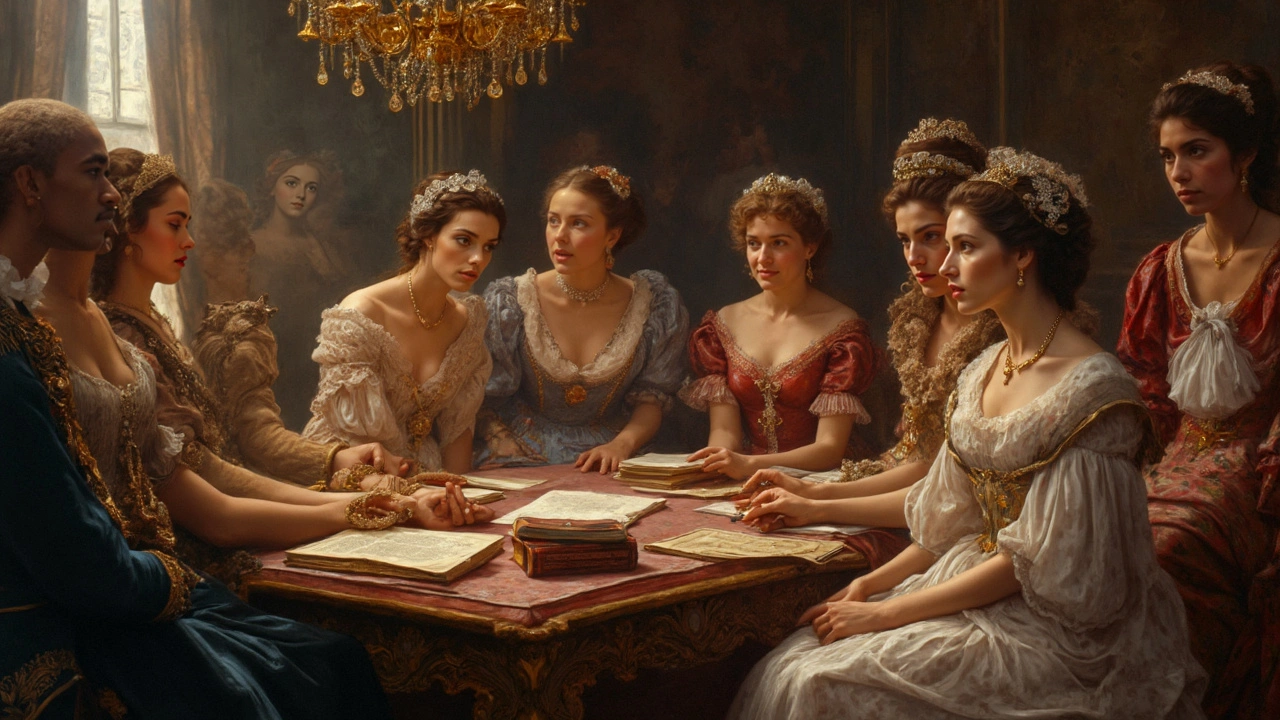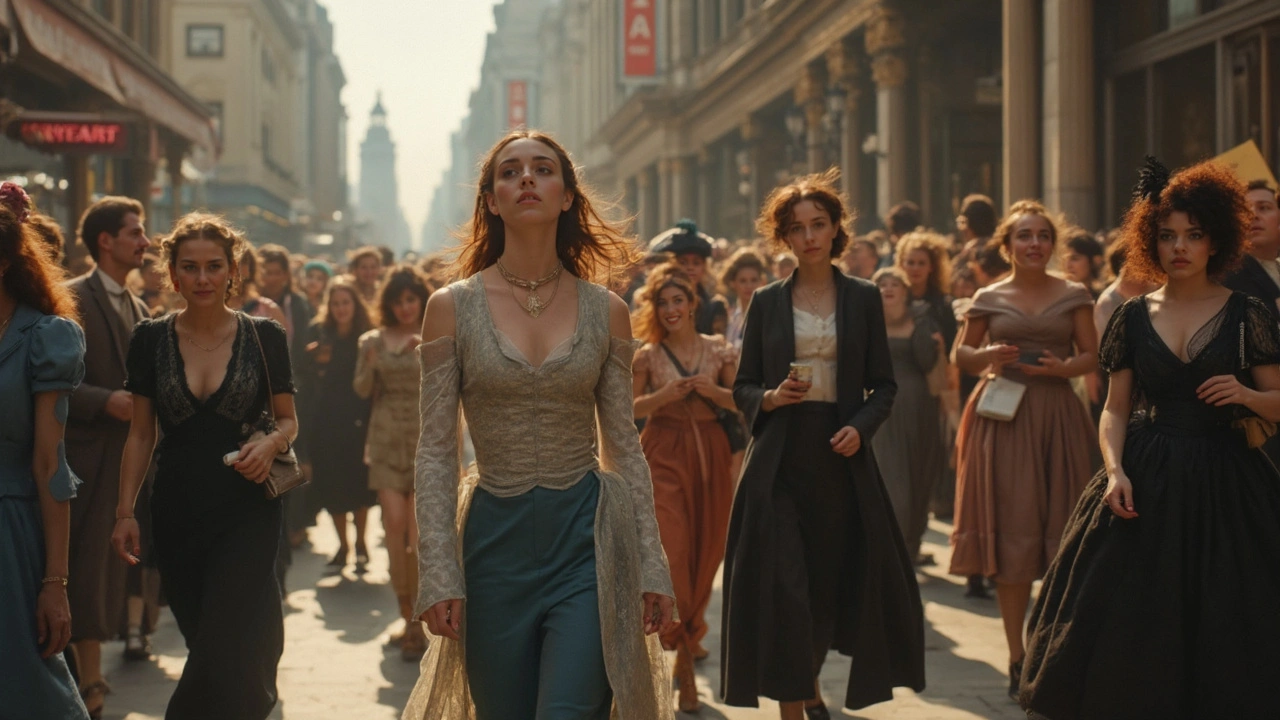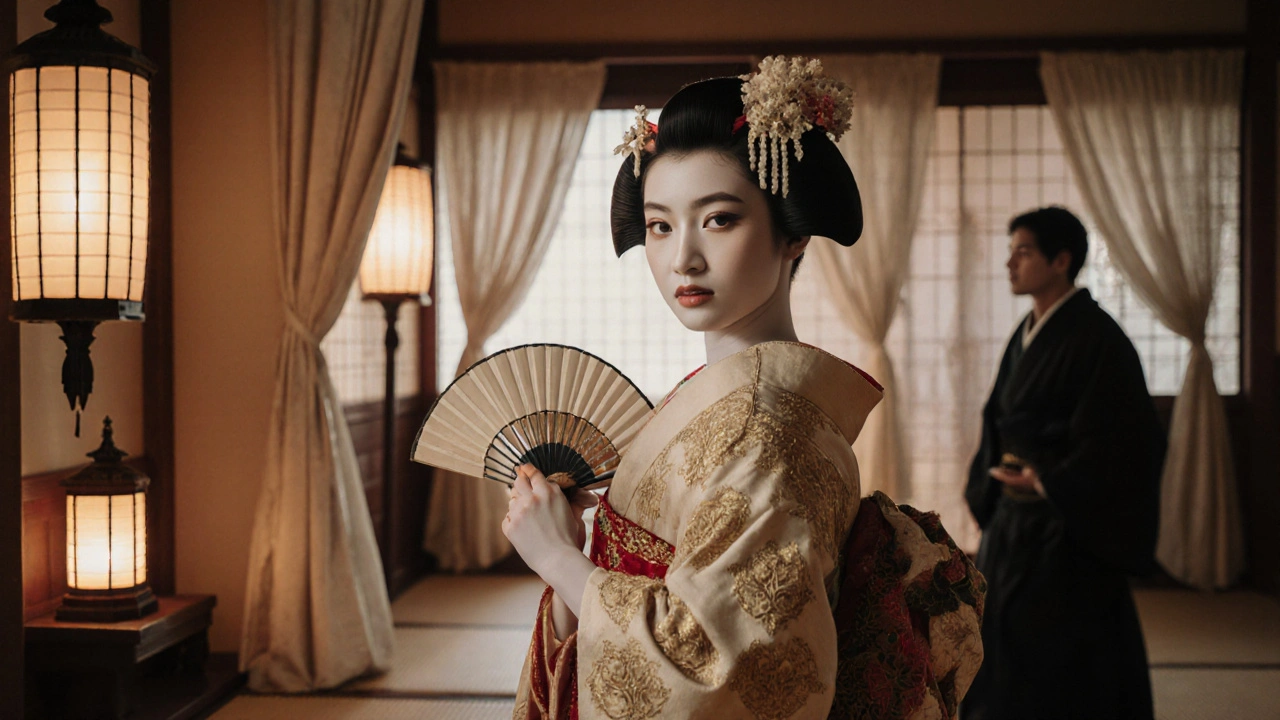Courtesan Impact on Women's Rights: Unveiling Their True Influence

Forget everything you’ve heard about courtesans being just background characters. These women knew how to work around rules in societies where women often had no real say. While everyone else was busy sticking to the script, courtesans created their own roles—and sometimes even bent the plot in bold new directions.
Ever wondered how some women managed to own property, run their own finances, or choose who they spent time with centuries before 'women's rights' was even a thing? That’s the world courtesans moved in. Sure, their lifestyles were unusual, and there was plenty of controversy, but they quietly carved out freedoms other women could only imagine. Their choices—good, bad, and everything in between—put cracks in the old ways. If you’re looking for proof that one person can start shifting mindsets, look no further than a courtesan who made it on her own terms.
- Key Points About Courtesans and Women's Rights
- What Was a Courtesan and Why Did They Matter?
- Ways Courtesans Pushed Gender Boundaries
- Famous Courtesans Who Changed the Rules
- Lessons from Courtesans for Modern Women's Rights
- FAQ: Courtesans and Gender Equality
Key Points About Courtesans and Women's Rights
It’s easy to underestimate the impact courtesans had on women's rights, but a closer look shows plenty of eye-opening facts. These women weren’t just talented entertainers—they operated where most women had little freedom. Their actions, choices, and influence reached beyond bedroom doors and shook up the social order.
- Courtesans were often the only women in history who could own property, sign contracts, and manage their own money—legally. While regular women were tied to their families or husbands, courtesans handled finances themselves, sometimes even investing in businesses.
- Some of the most famous courtesans, like Veronica Franco in Renaissance Venice and Madame de Pompadour in France, were trusted advisors to powerful leaders. That meant they could nudge political decisions or support artists and writers, which wasn’t an option for most women.
- While not every courtesan was a freedom fighter, their ability to move in elite circles made them role models of independence for other women. Their fashion, ideas, and attitudes spread far beyond their own worlds.
- Cultures like Ancient Greece and India had their own versions of courtesans—hetairai and tawaifs—who were often trained in literature, music, and debate. Many outshone men during public talks, undermining the myth that women should ‘stay quiet’ in society.
- Some laws changed because of controversies involving courtesans. For example, regulations about women’s rights to earnings in 18th-century France were debated after high-profile legal cases involving courtesans who challenged inheritance rules.
If you look at the stats, there’s a trend: In cities like Paris, up to 8% of property in certain neighborhoods during the 1700s was owned or managed by courtesans. That might sound small, but when women couldn’t usually own anything at all, it was a big deal.
| Contrast | Average Woman (18th c.) | Courtesan |
|---|---|---|
| Property Rights | Almost none | Often direct ownership |
| Access to Education | Rare, basic literacy | Literature, languages, arts |
| Financial Control | Controlled by male relatives | Personal management, investments |
This didn’t make every courtesan a champion of women’s rights, but their everyday choices chipped away at strict gender roles. The more freedom they claimed, the more cracks appeared in the rules holding women back.
What Was a Courtesan and Why Did They Matter?
If you picture a courtesan as just another name for a fancy escort, you’re missing the bigger story. A courtesan was basically a professional companion—someone who moved among the rich, powerful, or creative circles. They weren’t stuck following the same strict rules for women as everyone else. In places like Renaissance Italy, Imperial Japan, and 19th-century France, courtesans lived much freer lives than most women could ever hope for.
What set courtesans apart? They weren’t just about romance or charm. Real talk: many courtesans were smart, socially skilled, and way ahead of their time. They learned to read, write, play music, and speak different languages—stuff most women didn’t even get a crack at. This meant they could hold their own at dinner tables full of politicians, artists, or kings. Here’s something wild: In some cases, courtesans signed contracts, owned property, and made investments when the law blocked other women from even opening a bank account.
- History spotlight: During the French Belle Époque era, famous courtesans like Liane de Pougy and Cora Pearl raked in money, bought homes, and threw the kind of parties that turned heads across Europe.
- In 16th-century Venice, courtesans were among the few women allowed in literary salons, mixing with writers and philosophers. That access gave them real influence.
The importance of courtesans isn’t just the glitz. They pushed the limits of what women could do without getting shut out of society, and sometimes found back doors where there were no front doors. Their lives put cracks in what seemed like unbreakable gender rules. So, if you’re tracing the early roots of women's rights, these women are a crucial but often overlooked chapter.
| Century | Courtesan Role | Typical Women’s Rights |
|---|---|---|
| 1500s Venice | Property owners, salon attendees | Mainly home-bound, little education |
| 1800s France | Businesswomen, influencers | Couldn’t vote or open accounts |
| Japan (Edo) | Artists, writers | Strict family and social controls |
The bottom line? Courtesans mattered because they broke the mold—and proved women could hold power and independence, even when the odds were stacked against them.
Ways Courtesans Pushed Gender Boundaries
Courtesans weren’t just following the rules—they found all the loopholes they could. In times when most women couldn’t vote, own things, or even walk outside alone without someone judging them, courtesans often lived lives that flipped these ideas upside down.
Here’s how they did it:
- Financial Control: Unlike regular women stuck with no money of their own, courtesans could run bank accounts, invest in property, or even become loan sharks. Names like Cora Pearl in France and Veronica Franco in Venice had their own fortunes, which was rare for women back then.
- Education: Being a courtesan wasn’t just about looks. Many learned poetry, multiple languages, and politics. They had to keep powerful men entertained in conversation—think of them as social influencers of their day, only smarter.
- Freedom of Movement: Most women needed a chaperone everywhere. Courtesans could travel solo, go to the theater, or attend big social events on their own terms. That level of independence was nearly unheard of for women in those times.
- Legal Rights: Some courtesans in 17th-century France and India managed to get legal documents in their own names. When Parisian courtesan La Païva built a mansion on the Champs-Élysées in her own right, people talked—and stared. She didn’t care.
- Public Influence: Courtesans knew everyone who mattered in the city—artists, politicians, even royals. They had the ear of power in a way most nobles’ wives didn’t. They sometimes used this to push for social issues or protect women in trouble.
Check this out—here's a quick look at how their rights stacked up against typical women of their era:
| Right or Privilege | Courtesans | Other Women |
|---|---|---|
| Own Property | Often Possible | Rarely Allowed |
| Choose Partners | Yes | Usually Arranged |
| Education | Access to Tutors | Limited |
| Attend Social Events | Independently | With Male Escort |
| Direct Influence | High (Politics, Arts) | Low |
It wasn’t perfect—courtesans still faced harsh judgment. But by living openly and grabbing freedoms, they stretched what was possible for women around them. Their lives were proof that women’s rights weren’t just a distant hope, but something you could try to grab, even if everyone said you didn’t deserve it.

Famous Courtesans Who Changed the Rules
When people talk about courtesans and women's rights, names like Veronica Franco, Nell Gwyn, and Cora Pearl stand out. These women didn’t just make headlines back in the day—they pressed against boundaries that most women weren’t even allowed to question.
Take Veronica Franco, a 16th-century Venetian courtesan. She wasn’t just good at social networking—she wrote poetry, debated men in public, and stuck up for other women while most of her peers were still learning to read. Franco called out hypocrisy from rich men in her published letters. At one point, she stood up to the Inquisition, defending herself against charges just because she dared own her power as a woman and a courtesan. Most women could never defend themselves in court, let alone win the argument.
Now, look at Nell Gwyn from England. She started out selling oranges in a London theater, ended up on stage, and before long was King Charles II’s favorite companion. Nell never got the title of "queen," but she played politics with the big boys. She brought attention to causes for the poor, used her access to influence decisions, and even got pensions for her own children out of the king’s pocket. People began seeing that a woman with charm, brains, and guts could spark change, not just follow instructions.
Over in France, Cora Pearl became legendary for running her own show during the Second Empire (mid-1800s). She controlled her finances, set strict boundaries with her high-profile clientele, and refused to just be bought. Pearl threw outrageous parties and dared to push fashion and manners way past what was considered “proper.” Even her rivals admitted she made her own rules.
- Veronica Franco: Used her writing and legal battles to challenge male authority.
- Nell Gwyn: Leveraged her popularity to support charities and change how the public viewed women in her role.
- Cora Pearl: Managed her brand and earnings, paving the way for women who wanted to be financially independent.
Here's the thing—these women never claimed to be activists. But their moves chipped away at ideas about what women could and couldn’t do. Their independence and courage had real impact on gender roles and the conversation around women’s rights. You can see echoes of their choices in everything from workplace equality to the way we talk about consent and self-expression today.
Lessons from Courtesans for Modern Women's Rights
It’s wild how much we can actually learn from the lives of courtesans when talking about women's rights today. Sure, their worlds looked different from ours, but many of their struggles — and power moves — connect right back to things women still face in the modern world.
Let’s break down some key takeaways:
- Owning Your Value: Courtesans like Veronica Franco in 16th-century Venice didn’t let anyone decide what they were worth. She famously defended herself in court against the Inquisition. Today, asking for what you deserve at work or in your relationships takes a similar kind of guts.
- Financial Independence: While most women in history couldn't open a bank account, some courtesans ran their own finances, hired staff, and even invested in property. This shows how crucial money power is for independence — something experts still say is a game-changer for gender equality.
- Social Networking: You’d think social media was the power tool, but courtesans were the original networkers. Ninon de l’Enclos in 17th-century France built a huge circle of artists, politicians, and thinkers. Today, who you know still matters, and sometimes a great network opens doors faster than a résumé.
- Challenging Gender Roles: Courtesans could read, write, and be outspoken when other women were expected to stay quiet. They proved that bending gender rules wasn’t just possible — it could change lives. We still see this in modern movements pushing back against stereotypes and double standards.
- Having a Voice: A lot of courtesans were writers, poets, and even political advisers. They didn’t just keep their opinions to themselves. Speak up, share your story: it’s one of the main ways real change happens.
There’s no pretending everything was rosy for courtesans. Many paid a real price for living outside the lines. But their stories show that pushing limits — even just a little — can make a difference for others who come next.
Check out how their impact lines up next to key moments in women's rights history:
| Courtesan Influence | Modern Women's Rights Milestone |
|---|---|
| Ran businesses, owned property | First women's property laws (1800s-1900s) |
| Spoke publicly and wrote literature | Women's right to higher education (late 1800s+) |
| Challenged traditional roles | Suffrage and workplace equality (1900s+) |
Today, real power still comes when women know their worth, claim financial freedom, build networks, and speak their minds. The impact of courtesans is proof that even when systems seem impossible to change, pushing back is always worth it.
FAQ: Courtesans and Gender Equality
Curious about how courtesans really shaped women's rights and where the truth diverges from myth? Let’s clear up some confusion with straight-to-the-point questions and answers.
- Did courtesans have more rights than other women?
For their time, yes. In a lot of societies, especially in places like France and India, well-known courtesans could own property, manage money, and make their own decisions. That was rare for most women, who often couldn’t even sign contracts or travel alone. - Were courtesans respected or shamed?
It depended on the era and the culture. In Renaissance Italy or Mughal India, famous courtesans were sometimes admired for their wit, style, and influence. At the same time, they faced serious stigma. Popular courtesans could become celebrities, but respect always came with risk and gossip. - How did courtesans challenge gender roles?
They ran businesses, moved up social ranks, and dealt openly with powerful men—all things regular women barely dreamed of. Some even advised politicians or inspired laws about property and inheritance. - Did courtesans actually push for women's rights?
Not in the way we think of activists today. They weren’t out organizing protests, but their lives forced society to rethink what women were capable of. Their actions often set little examples that chipped away at strict gender rules. - Any famous courtesans who really stood out for women's empowerment?
Names like Veronica Franco (Venice, 16th century) or Cora Pearl (France, 19th century) pop up. Franco published poetry and even defended herself in court. Cora Pearl managed her own affairs, even as she shocked Paris high society with her choices. Their stories kept coming up when folks later talked about women’s independence. - What about stats or hard proof of impact?
It’s tough to get exact numbers, but we do know some facts:
| Era | Legal Rights for Courtesans | Average Woman's Rights |
|---|---|---|
| Venice 1500s | Sign contracts, own homes | No contract rights, few property rights |
| Mughal India 1700s | Earn income, train in arts | Could not work independently |
| Paris 1800s | Manage large estates, patronize artists | Most work/life controlled by husbands |
So, when you look past the stereotypes, courtesans really did punch holes in the old rules and offer sneak previews of what women’s rights could look like. They’re not classic role models, but their stories matter if you want to see how big changes can start in unexpected places.
